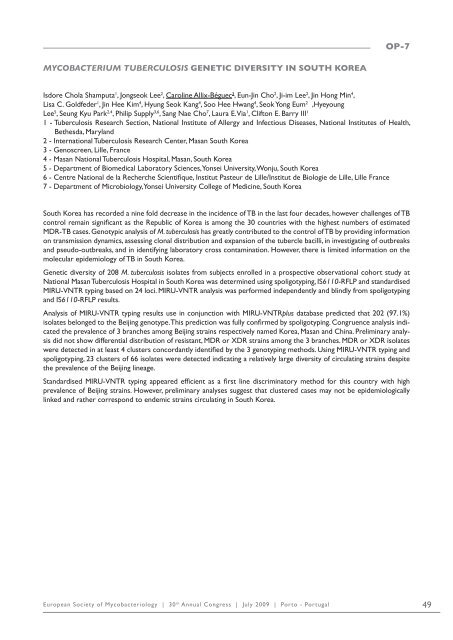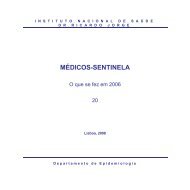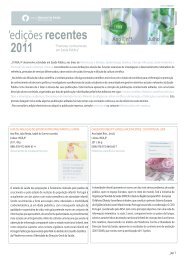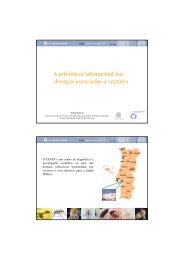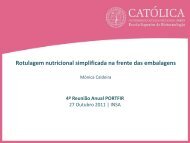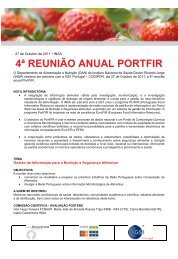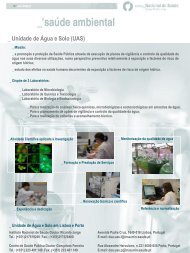European Society of Mycobacteriology - Instituto Nacional de Saúde ...
European Society of Mycobacteriology - Instituto Nacional de Saúde ...
European Society of Mycobacteriology - Instituto Nacional de Saúde ...
You also want an ePaper? Increase the reach of your titles
YUMPU automatically turns print PDFs into web optimized ePapers that Google loves.
op-7<br />
Mycobacterium tuberculosis genetic diversity in South Korea<br />
Isdore Chola Shamputa 1 , Jongseok Lee 2 , Caroline Allix-Béguec 3 , Eun-Jin Cho 2 , Ji-im Lee 2 , Jin Hong Min 4 ,<br />
Lisa C. Goldfe<strong>de</strong>r 1 , Jin Hee Kim 4 , Hyung Seok Kang 4 , Soo Hee Hwang 4 , Seok Yong Eum 2 ,Hyeyoung<br />
Lee 5 , Seung Kyu Park 2,4 , Philip Supply 3,6 , Sang Nae Cho 7 , Laura E. Via 1 , Clifton E. Barry III 1<br />
1 - Tuberculosis Research Section, National Institute <strong>of</strong> Allergy and Infectious Diseases, National Institutes <strong>of</strong> Health,<br />
Bethesda, Maryland<br />
2 - International Tuberculosis Research Center, Masan South Korea<br />
3 - Genoscreen, Lille, France<br />
4 - Masan National Tuberculosis Hospital, Masan, South Korea<br />
5 - Department <strong>of</strong> Biomedical Laboratory Sciences, Yonsei University, Wonju, South Korea<br />
6 - Centre National <strong>de</strong> la Recherche Scientifique, Institut Pasteur <strong>de</strong> Lille/Institut <strong>de</strong> Biologie <strong>de</strong> Lille, Lille France<br />
7 - Department <strong>of</strong> Microbiology, Yonsei University College <strong>of</strong> Medicine, South Korea<br />
South Korea has recor<strong>de</strong>d a nine fold <strong>de</strong>crease in the inci<strong>de</strong>nce <strong>of</strong> TB in the last four <strong>de</strong>ca<strong>de</strong>s, however challenges <strong>of</strong> TB<br />
control remain significant as the Republic <strong>of</strong> Korea is among the 30 countries with the highest numbers <strong>of</strong> estimated<br />
MDR-TB cases. Genotypic analysis <strong>of</strong> M. tuberculosis has greatly contributed to the control <strong>of</strong> TB by providing information<br />
on transmission dynamics, assessing clonal distribution and expansion <strong>of</strong> the tubercle bacilli, in investigating <strong>of</strong> outbreaks<br />
and pseudo-outbreaks, and in i<strong>de</strong>ntifying laboratory cross contamination. However, there is limited information on the<br />
molecular epi<strong>de</strong>miology <strong>of</strong> TB in South Korea.<br />
Genetic diversity <strong>of</strong> 208 M. tuberculosis isolates from subjects enrolled in a prospective observational cohort study at<br />
National Masan Tuberculosis Hospital in South Korea was <strong>de</strong>termined using spoligotyping, IS6110-RFLP and standardised<br />
MIRU-VNTR typing based on 24 loci. MIRU-VNTR analysis was performed in<strong>de</strong>pen<strong>de</strong>ntly and blindly from spoligotyping<br />
and IS6110-RFLP results.<br />
Analysis <strong>of</strong> MIRU-VNTR typing results use in conjunction with MIRU-VNTRplus database predicted that 202 (97.1%)<br />
isolates belonged to the Beijing genotype. This prediction was fully confirmed by spoligotyping. Congruence analysis indicated<br />
the prevalence <strong>of</strong> 3 branches among Beijing strains respectively named Korea, Masan and China. Preliminary analysis<br />
did not show differential distribution <strong>of</strong> resistant, MDR or XDR strains among the 3 branches. MDR or XDR isolates<br />
were <strong>de</strong>tected in at least 4 clusters concordantly i<strong>de</strong>ntified by the 3 genotyping methods. Using MIRU-VNTR typing and<br />
spoligotyping, 23 clusters <strong>of</strong> 66 isolates were <strong>de</strong>tected indicating a relatively large diversity <strong>of</strong> circulating strains <strong>de</strong>spite<br />
the prevalence <strong>of</strong> the Beijing lineage.<br />
Standardised MIRU-VNTR typing appeared efficient as a first line discriminatory method for this country with high<br />
prevalence <strong>of</strong> Beijing strains. However, preliminary analyses suggest that clustered cases may not be epi<strong>de</strong>miologically<br />
linked and rather correspond to en<strong>de</strong>mic strains circulating in South Korea.<br />
<strong>European</strong> <strong>Society</strong> <strong>of</strong> <strong>Mycobacteriology</strong> | 30 th Annual Congress | July 2009 | Porto - Portugal<br />
49


